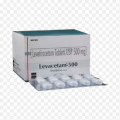Home / Categories / LEVERA XR-500MG

LEVERA XR-500MG
(10X10)
LEVETIRACETAM-500MG
ANTI-CONVULSANTS
INTAS PHARMACEUTICAL-AQUILA-DIVISION
Product Details
Levetiracetam
A to Z Drug Facts
Levetiracetam
Action
Indications
Contraindications
Route/Dosage
Interactions
Lab Test Interferences
Adverse Reactions
PrecautionsPatient Care Considerations
Administration/Storage
Assessment/Interventions
Patient/Family Education
(lev-eh-TEER-ah-see-tam)KeppraClass: Anticonvulsant
 Action Mechanism unknown; may selectively prevent hypersynchronization of epileptiform burst firing and propagation of seizure activity.
Action Mechanism unknown; may selectively prevent hypersynchronization of epileptiform burst firing and propagation of seizure activity.
 Indications Adjunctive therapy in partial onset seizures in adults with epilepsy.
Indications Adjunctive therapy in partial onset seizures in adults with epilepsy.
 Contraindications Standard considerations.
Contraindications Standard considerations.
 Route/Dosage
Route/Dosage
ADULTS: PO Initiate therapy with 500 mg bid; dose may be increased by 1000 mg daily every 2 weeks to a maximum daily dose of 3000 mg.
 Interactions None well documented.
Interactions None well documented.
 Lab Test Interferences None well documented.
Lab Test Interferences None well documented.
 Adverse Reactions
Adverse Reactions
RESP: Cough; pharyngitis; rhinitis; sinusitis. CNS: Somnolence; dizziness; headache; amnesia; anxiety; ataxia; depression; emotional lability; hostility; nervousness; paresthesia; vertigo. EENT: Diplopia. GI: Anorexia. OTHER: Asthenia; infection; pain.
 Precautions
Precautions
Pregnancy: Category C. Lactation: Undetermined. Children: Safety and efficacy not established in patients < 16 year of age. Impaired renal function: Should use reduced doses. Withdrawal seizures: Do not discontinue abruptly because of possible increased seizure frequency. Dialysis patients: Administer supplemental doses because drug is removed during the treatment.
PATIENT CARE CONSIDERATIONS
 Administration/Storage
Administration/Storage
- Store at room temperature. Excursions permitted to 15° to 30°C (59° to 86°F).
- Administer orally as adjunct therapy with or without food.
- Do not administer to pregnant women unless it is determined that the benefit to the mother justifies the potential risk to the fetus.
 Assessment/Interventions
Assessment/Interventions
- Obtain patient history, including drug history and any known allergies.
- Monitor patient for potential hypersensitivity.
- Monitor for signs and symptoms of asthenia, somnolence, and dizziness that might occur, especially in the first weeks of treatment.
- Monitor patient's CBC and for signs and symptoms of infection.
- Monitor renal function.
- Exercise caution to assure that patients are withdrawn gradually from levetiracetam or any other antiseizure drug to avoid the potential of increased seizures.
OVERDOSAGE: SIGNS & SYMPTOMS Drowsiness
 Patient/Family Education
Patient/Family Education
- Inform patient that levetiracetam does not cure the cause of seizure activity but will control symptoms.
- Caution patient to take the dose exactly as prescribed and not to stop taking the medication even if feeling better. Instruct patient not to increase or decrease the dosage.
- Teach family that seizure control requires rigid adherence to the prescribed regimen, as noncompliance is a major cause of therapeutic failure.
- Caution patient to stop taking levetiracetam or any other antiseizure medication abruptly; there is potential for increased seizure activity.
- Teach patient/family to maintain a seizure frequency chart indicating the date, time, and nature of all seizure events as prescriber can use this record to evaluate treatment, make dosage adjustments, and alter drug selections.
- Warn patient against using alcohol, antihistamines, and or other CNS depressants as these will intensify the depressant effects of antiseizure medications.
- Advise patient that levetiracetam may cause dizziness and somnolence.
- Instruct patient/family that if seizures occur, the patient should be protected from injury.
- Caution patient/family that patient should neither drive a car, operate complex machinery, or engage in any other hazardous activity until knowing the reaction to the drug.
- Advise patient to notify physician immediately if pregnant, planning to become pregnant, or planning to breastfeed.
Books@Ovid
Copyright © 2003 Facts and Comparisons
David S. Tatro
A to Z Drug Facts
Substitutes




